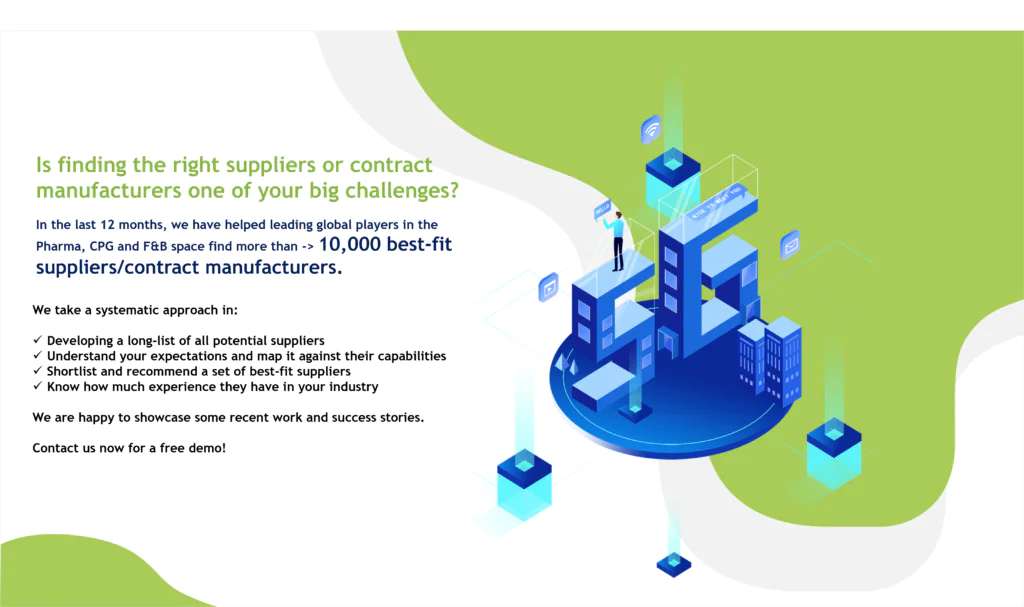By: George Mathew
Table of content
- Best ways to evaluate a starch manufacturer’s performance
- The major challenge that is faced by starch manufacturers while procuring the materials is the limited market supply
- How SpendEdge can help you overcome this challenge
- Performance management strategies
- Best practices for performance management in manufacturing
- The success story of how SpendEdge helped one of its clients
Starch is a complex carbohydrate found in plants, serving as an energy storage molecule made of glucose units linked together. Starch is primarily extracted from plants like corn, wheat, or potatoes. The manufacturing process involves washing, crushing, and grinding the raw material to release starch granules. These granules are then separated from other components through a combination of water and centrifugal force. Afterwards, the starch is dried and often modified for various industrial applications. The resulting product can be used in food, paper, textiles, and many other industries as a versatile carbohydrate source. There are two main types of starch: amylose and amylopectin. Amylose is a linear, long-chain starch molecule, while amylopectin is branched with numerous shorter chains. Additionally, starches can be classified as native (unmodified), modified (chemically altered for specific purposes), and resistant starch (not fully digestible in the small intestine).
Best ways to evaluate a starch manufacturer’s performance
The first step is to ensure the starch is free from contaminants, foreign particles, and unwanted chemicals. Verify that moisture levels meet industry standards, as excess moisture can lead to spoilage. Test for any undesirable substances, such as heavy metals or microorganisms. Secondly, measure the ability of the starch to form and maintain a gel structure, critical in food and pharmaceutical applications. Assess the starch’s viscosity at different temperatures and shear rates to understand its thickening properties. Evaluate how the starch performs under varying conditions, including pH levels and freeze-thaw cycles, to ensure it meets application requirements. The third step is to determine if the starch exhibits shear-thinning, a valuable property in applications like sauces and gravies. Examine how the starch viscosity changes with temperature, which is vital in cooking processes and industrial applications. Later the fourth stage consists of conducting accelerated aging studies to simulate long-term storage conditions and assess any performance degradation. Monitor changes in color, texture, and appearance over time, as these can impact consumer acceptability and shelf life. Lastly, gather feedback from customers who use the starch in their processes or products. This real-world feedback can help identify any issues or areas for improvement.
The major challenge that is faced by starch manufacturers while procuring the materials is the limited market supply
One major challenge faced by starch manufacturers during the procurement and evaluation process is the limited market supply of quality raw materials. Starch production heavily relies on crops like corn, wheat, and potatoes, which are subject to various factors like weather conditions, crop diseases, and fluctuations in demand. These factors can lead to inconsistent or inadequate supplies of high-quality raw materials, affecting production capacity and product quality. Manufacturers must constantly monitor and adapt to market conditions, invest in supply chain resilience, and explore alternative sources to secure a stable and sustainable supply of raw materials to meet their production and quality assurance needs.
How SpendEdge can help you overcome this challenge
Category analysis to make category decisions:
You can make category decisions based on our precise data on cost drivers that we gather through cost analysis. Accurately estimate the real cost of corn, wheat, potatoes, and tapioca that you are buying. With this information, you can negotiate better supplier rates, especially in times of market volatility. Get a dashboard view of cost drivers and market-shaping trends like the change in prices of potatoes and wheat and obtain relevant patterns extracted from large volumes of data. Perform comparative studies of suppliers on multiple parameters, undertake supplier cost comparisons for diverse “country sourcing markets”, gain more visibility on supplier costs, and predict cost movements.
Supplier landscape analysis for choosing the right suppliers:
Our supplier landscape analysis will help you strengthen your supplier base with trustable and reliable suppliers. Our methodology for narrowing down suppliers goes beyond historical filters like revenue and profits, performance, and service quality to find vendors who can bring the desired value to your business. 70% of starch is corn-based and it becomes necessary to get an appropriate supplier for its procurement. We provide you with all the information about the corn supply market like supplier past performance, price, quality, duration from purchase to delivery, etc. With our supplier risk intelligence service, you get custom alerts for a host of supplier risk categories so that you can act on them instantaneously, leaving nothing to chance.
Performance management strategies

1. Line-shift goals
To effectively manage line shifts in manufacturing, production planning and scheduling systems are often utilized by manufacturers. These systems ensure a smooth transition between different production configurations and help address challenges such as downtime, quality control issues, employee fatigue, and planning issues. It is essential for production leaders to establish clear and measurable objectives for each line shift or individual worker that align with organizational goals, thereby ensuring that production goals are met.
2. Individual meetings and communication
Manufacturing leaders should incorporate individual meetings and communication into their performance management strategy. Providing regular constructive feedback to employees on their performance can significantly improve performance and boost employee engagement. Moreover, offering coaching and development opportunities can enhance employees’ skills and capabilities.
3. Continuous training
Continuous training is also crucial in manufacturing as it enables workers to regularly acquire new skills. This approach not only improves employee performance and innovation but also fosters employee engagement and retention. An example of a successful continuous learning model is ever boarding, a modern approach to employee onboarding and training that recognizes learning as an ongoing process, diverging from the traditional “one-and-done” onboarding model.
4. Performance management tools
Implementing performance management tools can automate ongoing employee evaluation and align employee performance with key manufacturing KPIs such as production quality, machine uptime, and labor utilization. These tools also help identify continuous improvement opportunities, enabling manufacturing leaders to adapt and refine approaches based on feedback and outcomes.
Best practices for performance management in manufacturing

1. Goal alignment:
It is imperative for organisations to ensure that their performance management processes are in alignment with the overarching organisational goals. Clear and unambiguous communication of objectives to employees at all levels, coupled with the linkage of individual and team performance metrics to broader manufacturing and business objectives, is essential. This approach fosters a sense of purpose within frontline teams, promotes active engagement among workers, and facilitates employees’ comprehension of how their endeavours contribute to the company’s overall success.
2. Real-time tracking and data analytics:
Implementing real-time monitoring of production and shop floor processes and equipment performance using AI and connected worker technology is essential in modern industrial settings. The integration of data analytics and AI-driven processing provides valuable insights into worker performance trends, helps identify bottlenecks, and facilitates data-driven decision-making. Real-time operations monitoring not only allows for proactive interventions to maintain efficiency but also ensures fairness, accuracy, and transparency in performance measurement.
3. Employee training and development programs:
Prioritize continuous training and development programs for manufacturing personnel. Provide frontline workers with the essential skills to adapt to changing technologies and operational needs. Utilize performance management systems and digital tools such as skills matrices to identify skill gaps, establish training objectives, and monitor progress, guaranteeing a skilled and adaptable workforce.
4. Regular performance evaluation and feedback:
Regularly conduct performance evaluations that offer constructive and timely feedback to employees. Use these evaluations as chances to acknowledge accomplishments, tackle areas for growth, and establish new performance objectives. Cultivate transparent communication between managers and employees to promote ongoing improvement.
5. Continuous improvement initiatives:
Align performance assessment systems with continuous improvement efforts such as Lean or Six Sigma by integrating “kaizen” principles. Utilize performance metrics data to pinpoint areas for process enhancement, waste minimization, and efficiency boosts. This guarantees that performance assessment not only evaluates but also actively contributes to the continual improvement of manufacturing processes.
The success story of how SpendEdge helped one of its clients
In the FMCG (Fast-Moving Consumer Goods) industry, starch plays a crucial role as a thickening agent, stabilizer, and source of carbohydrates in various food and non-food products. Starch in FMCG products also enhances texture, shelf life, and mouthfeel while serving as a cost-effective ingredient in the manufacturing processes.
A US-based client wanted to understand a comprehensive category analysis of native starch and modified starch used in the FMCG industry. The client also wanted to examine various aspects of the starch market including supplier landscape, price fluctuations, potential risks, etc.
In order to tackle this issue, the client reached out to SpendEdge’s team of experts. They conducted a detailed assessment of the situation and provided the client with valuable insights on emerging trends and potential risks that could impact their supply chain. The information helped the client to address these issues before they could cause any harm to the business operations and provided information on sustainable practices that are widely adopted globally. Additionally, they helped the client identify gaps in their sustainability efforts.
Our solutions enabled the client to effectively manage the sourcing of scarce and perishable materials corn, wheat, and potatoes while reducing the risk of delays in starch development and ensuring a consistent supply of materials.

Contact us now to solve your procurement problems!
Author’s Details
George Mathew
Associate Vice President, Sourcing and Procurement Intelligence
George is a procurement specialist at Infiniti Research and provides advisory services to clients across the pharmaceutical, CPG & FMCG, energy, and automotive sectors. He specializes in the procurement areas of industry benchmarking, cost modeling, rate card benchmarking, negotiation advisory, and supplier intelligence.




